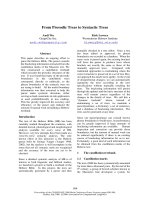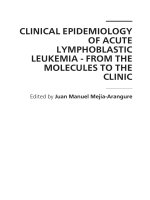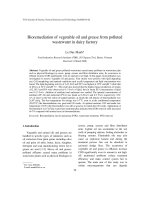VASCULOGENESIS AND ANGIOGENESIS – FROM EMBRYONIC DEVELOPMENT TO REGENERATIVE MEDICINE doc
Bạn đang xem bản rút gọn của tài liệu. Xem và tải ngay bản đầy đủ của tài liệu tại đây (17.01 MB, 238 trang )
VASCULOGENESIS AND
ANGIOGENESIS –
FROM EMBRYONIC
DEVELOPMENT TO
REGENERATIVE MEDICINE
Edited by Dan T. Simionescu
and Agneta Simionescu
Vasculogenesis and Angiogenesis –
From Embryonic Development to Regenerative Medicine
Edited by Dan T. Simionescu and Agneta Simionescu
Published by InTech
Janeza Trdine 9, 51000 Rijeka, Croatia
Copyright © 2011 InTech
All chapters are Open Access distributed under the Creative Commons Attribution 3.0
license, which permits to copy, distribute, transmit, and adapt the work in any medium,
so long as the original work is properly cited. After this work has been published by
InTech, authors have the right to republish it, in whole or part, in any publication of
which they are the author, and to make other personal use of the work. Any republication,
referencing or personal use of the work must explicitly identify the original source.
As for readers, this license allows users to download, copy and build upon published
chapters even for commercial purposes, as long as the author and publisher are properly
credited, which ensures maximum dissemination and a wider impact of our publications.
Notice
Statements and opinions expressed in the chapters are these of the individual contributors
and not necessarily those of the editors or publisher. No responsibility is accepted for the
accuracy of information contained in the published chapters. The publisher assumes no
responsibility for any damage or injury to persons or property arising out of the use of any
materials, instructions, methods or ideas contained in the book.
Publishing Process Manager Marina Jozipovic
Technical Editor Teodora Smiljanic
Cover Designer Jan Hyrat
Image Copyright Norph, 2011. Used under license from Shutterstock.com
First published October, 2011
Printed in Croatia
A free online edition of this book is available at www.intechopen.com
Additional hard copies can be obtained from
Vasculogenesis and Angiogenesis – From Embryonic Development
to Regenerative Medicine, Edited by Dan T. Simionescu and Agneta Simionescu
p. cm.
ISBN 978-953-307-882-3
free online editions of InTech
Books and Journals can be found at
www.intechopen.com
Contents
Preface IX
Part 1 Developmental Biology 1
Chapter 1 Human Embryonic Blood Vessels: What Do
They Tell Us About Vasculogenesis and Angiogenesis? 3
Simona Sârb, Marius Raica and Anca Maria Cîmpean
Chapter 2 Cardiac Vasculature: Development and Pathology 15
Michiko Watanabe, Jamie Wikenheiser, Diana Ramirez-Bergeron,
Saul Flores, Amir Dangol, Ganga Karunamuni, Akshay Thomas,
Monica Montano and Ravi Ashwath
Chapter 3 Vascular Growth in the Fetal Lung 49
Stephen C. Land
Chapter 4 Apelin Signalling: Lineage Marker and
Functional Actor of Blood Vessel Formation 73
Yves Audigier
Part 2 Endothelial Progenitor Cells 97
Chapter 5 Regulation of Endothelial Progenitor
Cell Function by Plasma Kallikrein-Kinin System 99
Yi Wu and Jihong Dai
Chapter 6 Vasculogenesis in Diabetes-Associated
Diseases: Unraveling the Diabetic Paradox 107
Carla Costa
Part 3 Cancer Research 131
Chapter 7 Modeling Tumor Angiogenesis with Zebrafish 133
Alvin C.H. Ma, Yuhan Guo,
Alex B.L. He and Anskar Y.H. Leung
VI Contents
Chapter 8 Therapeutic and Toxicological Inhibition
of Vasculogenesis and Angiogenesis
Mediated by Artesunate, a Compound
with Both Antimalarial and Anticancer Efficacy 145
Qigui Li, Mark Hickman and Peter Weina
Part 4 Regenerative Medicine 185
Chapter 9 The Mechanics of Blood Vessel Growth 187
Rui D. M. Travasso
Chapter 10 A Novel Adult Marrow Stromal
Stem Cell Based 3-D Postnatal De Novo
Vasculogenesis for Vascular Tissue Engineering 205
Mani T. Valarmathi
and John W. Fuseler
Preface
The formation, development and persistence of most major organs and tissues depend
on adequate vascularization. Blood vessels are among the first functional structures
that form during embryonic development. Defects in blood vessel formation
frequently lead to congenital malformations which need to be corrected by surgery or
by using regenerative medicine approaches. After birth, existing blood vessels grow in
size but new blood vessel formation is poorly represented in healthy individuals. This
status quo is disturbed in numerous pathological conditions such as wound healing,
rheumatoid arthritis, retinopathy, ischemia, and tumor and metastasis. Tumor growth
depends greatly on extensive vascularization, and thus cancer research has focused
tremendously on agents capable of blocking blood vessel formation.
During aging, blood vessels deteriorate slowly due to lipid and calcium deposition,
inflammation, auto-immune reactions, and infections, potentially affecting all major
organs and systems. Vascular diseases are a leading cause of morbidity and mortality
worldwide and diseased blood vessels require surgical replacement with engineered
devices. Tissue engineering and regenerative medicine approaches are diligently
working on two main avenues: first, generation of living blood vessels of various
calibers to serve as surgical replacements and second, development of vascularized
living tissue substitutes with intrinsic 3D blood vessel networks to sustain effective
organ perfusion.
New blood vessels may arise by two processes, vasculogenesis and angiogenesis.
Endothelial cells are fundamental and common to both processes: however they differ
in location, mechanisms of initiation and source of precursor cells. Vasculogenesis is a
term describing the general process of de novo blood vessel formation during
embryologic development of the cardiovascular system. This refers to two distinct
inception scenarios: first, production of new endothelial cells in a developing embryo
followed by development of a primordial vascular tree and second, generation of
blood vessels in an adult avascular tissue area from precursor cells that migrate and
differentiate to endothelial cells as a response to local signals.
Angiogenesis is the process by which new blood vessels form by “sprouting” of
endothelial cells from pre-existing blood vessels; after “branching”, these new “trees”
are then reorganized, “pruned” and remodeled to eventually become 3D networks
X Preface
and also larger diameter vessels. Since this process is graphically similar to the growth
and development of trees, there is no wonder that most terms used in angiogenesis are
derived from the science of forestry.
Before the discovery of endothelial progenitor cells (EPCs) in the late 90’s, the general
consensus was that de novo vasculogenesis was restricted to the embryonic
development arena and angiogenesis was only limited to growth and remodeling of
adult vascular tissue. It is now known that as a response to injury, EPCs that normally
reside in the bone marrow are mobilized into the circulation, migrate to avascular
areas, differentiate into mature endothelial cells and develop vascular networks. In
addition, bone marrow derived stem cells can act as “cytokine factories” and boost
remodeling by secreting growth factors that help mature the developing “vascular
tree”. These cells have now become a central theme around which tissue engineering
and regenerative medicine revolves. Vascular tissue engineering using scaffolds and
stem cells has made great progress in recent years, highlighted by numerous
successful animal experiments and recent clinical trials.
As shown above, basic and applied research in vasculogenesis and angiogenesis has
come a long way and has elicited tremendous interest. The study of blood vessel
formation is an essential component of embryonic development, congenital
malformations, degenerative diseases, and cancer. It is probably almost impossible to
contain and review all the research performed in this field in one single book.
The purpose of this book is to highlight novel advances in the field, focusing on four
aspects of relevance. Esteemed authors from the USA, Europe and Asia, selected from
a variety of fields summarize knowledge in their area of expertise and also contribute
with authentic original experimental data to each chapter. The first section focuses on
the early stages of human embryogenesis, development of the cardiac vasculature, the
fetal lung and a novel signaling marker for vessel formation. This is followed by a
section that focuses on regulation of EPCs and their role in diabetic vascular diseases.
The role of vasculogenesis and angiogenesis in cancer is highlighted by two chapters
that reveal the power of animal models and inhibitors of vasculogenesis and
angiogenesis. Finally, looking towards the future, the last chapter highlights use of
current knowledge towards regeneration of blood vessels using precursor cells,
scaffolds and the proper mechanical cues.
This book is a good source of information for scientists interested in the intricacies of
blood vessel formation, maturation, disease and replacement. It is also adequate for
graduate students and medical students who wish to acquire basic updated
information in the field.
Strolling through it, the reader will appreciate the crucial involvement of various
precursor cells, starting with the primordial vascular cells in the embryo, the
mesenchymal progenitor cells in healing and pathology and the lessons one can learn
from the extraordinary ability of the cancer cells to manipulate blood vessel formation.
Preface XI
We are hoping that this book will help raise interest in the field and will entice new
investigators to dwell into the complex and fascinating world of blood vessel
formation, from the early days of embryonic development to the prospects of creating
blood vessels in vitro for use as surgical replacements.
Dan T. Simionescu
Agneta Simionescu
Clemson University, Clemson, SC,
USA
Part 1
Developmental Biology
1
Human Embryonic Blood Vessels:
What Do They Tell Us About
Vasculogenesis and Angiogenesis?
Simona Sârb, Marius Raica and Anca Maria Cîmpean
“Victor Babeş” University of Medicine and Pharmacy, Timişoara,
România
1. Introduction
The first functioning system during embryonic development is the cardiovascular system;
the development of other organs and systems is in strict dependence to the emergence and
development of blood vessels. Although the interest in the structure and functioning of the
vascular system has existed since antiquity, there are still gaps in knowledge of the vascular
system development issues. The process of blood vessel formation plays an important role
during prenatal development; in the postnatal life, with few exceptions, this process is,
normally, poorly expressed. Usually, an augmentation of postnatal vasculogenesis and
angiogenesis is associated with pathological situations: healing wounds, certain
degenerative diseases (rheumatoid arthritis, diabetic retinopathy, psoriasis) or malignant
growth and metastasis. In this context, it becomes imperative to understand the mechanisms
and factors involved in tumor angiogenesis. Mainly, tumor angiogenesis repeats - at least in
some aspects - embryonic stages of vascular development. Most studies related to
embryonic vascular system development were performed on embryos from other species,
and / or cell cultures. Detailed morphogenesis studies, demonstrated the existence of
differences between the primitive circulatory system in fish and mammals. In 2004, Ginis
and collaborators have conducted a comparative study on cultures of human embryonic
versus mice endothelial cells. The authors demonstrated the existence of species-specific
differences that are related not only to quantitative aspects, but also to the existence of
different signaling pathways. Even when using the same signaling pathways in cells from
different species, different members of the same family were involved. Studies on human
embryonic tissues, from the points of view stated above, are very rare and controversial; for
example, the morphogenesis of embryonic vessels and, the temporal sequence for the onset
of smooth muscle actin expression are very well studied and characterized in birds and
mice, but not in humans.
2. Material and methods
We investigated the blood vessel morphology, and distribution in human embryos, of
different gestational ages. Since the only direct microscopic argument for active
angiogenesis is endothelial cell proliferation, we also investigated this parameter, in order to
evaluate vasculogenesis versus angiogenesis.
Vasculogenesis and Angiogenesis – From Embryonic Development to Regenerative Medicine
4
2.1 Materials
This study was conducted on five, seven, and twenty four weeks human embryos; whole
embryo specimens were obtained by therapeutic abortions, after signed patient consent,
according to the Ethic Comity guidelines, and in compliance with the Helsinki Declaration
of Human Rights.
2.2 Methods
The specimens were fixed in buffered formalin and embedded in paraffin according to the
usual histological technique. Five-micrometer thick sections were stained with a routine
Hematoxylin - Eosin method for morphological diagnosis. Additional sections were
prepared for immunohistochemistry, as follows: microwave pH6 citrate buffer antigen
retrieval was performed, followed by endogenous peroxidase inhibition with 3%
hydrogen peroxide. In pursuing our objectives, first we investigated the morphology of
embryo-fetal vessels by double immunostaining: we used as endothelial marker CD34
(clone QBEnd 10, dilution 1:25), and as a perivascular cell marker- smooth muscle actin
(SMA, ready to use, clone 1A4 antibody); the cell nuclei were stained with modified Lille’s
hematoxylin. To assess endothelial cell proliferation, we used another double
immunostaining: CD34/Ki-67 (ready to use, clone MIB1 antibody). After incubation with
the primary antibody, the LSAB system was applied; the final reaction product was, for
the first antibody, visualized in brown, with diaminobenzidine, and, for the second
antibody, in red, with aminoethyl carbazole. The entire immunohistochemical technique
was performed with DakoCytomation Autostainer. The slides were mounted with an
aqueous medium, and examined with a Nikon Eclipse 600 microscope; images were
taken, and processed with Lucia G system. On each slide we evaluated the
expression/coexpression of the above mentioned markers in embryo-fetal vessels.
3. Results
We assessed embryonic blood vessels in both developing organs, and surrounding
mesenchyme; the results varied with the embryo’s gestational age, and the staining method.
3.1 Hematoxylin-Eosin staining
As a general remark, this type of staining allowed us to identify with certainty, only vessels
with developing/obvious lumen; the vascular islands and vascular cords were less
noticeable.
Embryonic tissue examination revealed the presence of blood vessels of different sizes, with
different degrees of maturation, in all cases. In five and seven weeks old embryos, the
mesenchymal tissue contained small blood vessels with relatively large lumens, thin walls,
occasionally surrounded by perivascular cells. In the nervous organs, such small blood
vessels were present in the subependymal space, at the boundary between white and gray
matter, and in piamater (Fig.1).
In five weeks embryos, vessels were extremely rare in the mesenchyme of developing organs,
such as esophagus, compared to the peripheral (subperidermal) mesenchyme, and were
represented by vascular islands and cords, and small vessels, with thin walls (Fig. 2). Only
on rare occasions we found mature vessels, with a well structured wall; some of these
vessels had emerging endothelial cords (Fig. 3).
Human Embryonic Blood Vessels:
What Do They Tell Us About Vasculogenesis and Angiogenesis?
5
(a) (b)
(c)
Fig. 1. Cross sections of seven weeks embryo spinal cord, HE staining. In the subependymal
space there are very small vessels, recognizable by the presence of megalocytes (subfig. a –
arrow, X100). If at the white-gray matter border, there are small vessels with/without
narrow lumen (subfig.b, X100), in the meningeal membranes there are vessels with larger
lumen, that have perivascular cells attached to their endothelial cells (subfig.c, X400).
(a) (b)
Fig. 2. Five weeks embryo mesenchyme, HE staining. We frequently identified vascular
islands, cords, and vessels with lumen, in the same microscope field (subfig.a, X100);
sometimes we found concentrations of branched and anastomozed vessels, that presented
budding phenomenon (subfig.b, X100)
Vasculogenesis and Angiogenesis – From Embryonic Development to Regenerative Medicine
6
In seven weeks embryos, the vessels were more numerous in the mesenchyme of the already
differentiated organs as the lungs and heart, than in the peripheral mesenchyme. Unlike
vessels in other areas of mesenchyme, lung vessels –located close to the bronchi- were
characteristically elongated, and their inner tip already presented perivascular cells (Fig.4.a,
X200). Again we observed the coexistence, in the same microscope field, of vascular islands,
cords, and vessels with large lumen (Fig.4.b, X200).
Fig. 3. Blood vessel with arterial morphology, that has in its upper part a cord-like cell
proliferation (HE, X400).
(a) (b)
Fig. 4. Seven weeks embryo lung, HE staining. Next to a bronchus in the canalicular phase
of development rests an elongated blood vessel that has perivascular cells (subfig. a, X200).
Further from the bronchi, the vascular islands coexist with blood vessels with wide lumen
(surfing. b, X200).
3.2 CD34 / SMAct
Blood vessel classification was made according to the criteria described by Gee and his
colleagues (2003). We classified as immature vessels those items that showed no obvious
Human Embryonic Blood Vessels:
What Do They Tell Us About Vasculogenesis and Angiogenesis?
7
lumen, and were positive only for CD34; intermediate vessels reacted positive for CD34,
showed no perivascular cells (negative reaction for SMA), but showed obvious lumen;
mature vessels showed lumen lined by CD34 positive cells, doubled by SMA positive
perivascular cells.
In five weeks old embryos, the expression of the two markers depended on the studied area.
Thus, in the mesenchyme adjacent to differentiating tissues/organs, the CD34 positive
isolated cells, vascular cords (Fig.5) and intermediate CD34 positive/ SMAct negative
vessels were predominant. Mature blood vessels positive for both CD34 and SMAct, were
detected in the undifferentiated mesenchyme, away from the developing organs; the SMA
expression was weak and inconstant (Fig.6).
Fig. 5. Isolated CD34 positive cells, and CD34 positive/ SMAct negative vascular cords were
the most frequent vascular structures found in the mesenchyme of five weeks old embryos
(CD34/SMAct, X400).
Fig. 6. In five weeks embryos only axial vessels begin to acquire pericytes- positive for
SMAct (CD34/ SMAct, X1000).
In seven weeks old embryos, the aspects encountered in earlier stages were maintained, with
the exception of larger vessels that had an almost complete investment of SMAct positive
perivascular cells (Fig.7).
Vasculogenesis and Angiogenesis – From Embryonic Development to Regenerative Medicine
8
Fig. 7. In the large blood vessel, with a more complex wall structure, the CD34 positive
endothelial cells are almost completely surrounded by SMAct positive cells (X400)
In 24 weeks old fetus we studied the expression of CD34/SMAct in two locations: lungs –as a
representative for parenchyma organs-, and esophagus –representative for hollow organs.
The lung vessels, from the large ones that accompany the bronchi, to the small, interalveolar
capillaries, were all positive for both markers; this means that at 24 weeks, the lung vessels
are of mature type (Fig.8). There were some exceptions: at the periphery of the lung
parenchyma, immediately under the pleura, we identified cord-like vascular structures
positive only for the endothelial marker (immature vessels).
Fig. 8. Large lung blood vessel (right) with CD34 positive endothelium, and a thick SMAct
positive muscle layer; note the presence of numerous CD34 positive cells (probably
fibroblasts) in the outer adventitia. In the lung parenchyma, the interalveolar capillaries are
CD34/ SMAct positive (X200).
Human Embryonic Blood Vessels:
What Do They Tell Us About Vasculogenesis and Angiogenesis?
9
In the esophageal wall, the reaction for the two markers was positive in all layers, but with
different pattern from one layer to another. In the mucosa of the fetal esophagus immature,
CD34 positive /SMAct negative, cord-like vascular structures, and intermediate vessels
were observed (Fig.9, subfigure a). The blood vessels of the submucosa had a larger lumen
with a more complex wall structure; the proportion of CD34 positive/ SMAct positive
vessels versus CD34 positive/ SMA negative ones was approximately equal. Also, the
vessels in this layer tended to come in pairs: one immature vessel accompanied by one
intermediate/mature vessel (Fig.9, subfigure b). In the connective tissue of the muscular
layer, blood vessels were mainly of immature type (CD34 positive /SMA negative), with a
marked tendency for branching (Fig.9, subfigure c). In contrast, blood vessels in adventitia
were mostly mature vessels, positive for both endothelial and smooth muscle actin markers
(Fig.9, subfigure d).
(a) (b)
(c) (d)
Fig. 9. Esophagus of 24 weeks fetus. Subfigure a: vascular cord with the tendency to form
lumen, and small CD34 positive/SMAct negative vessels, in the mucosa (X400). Subfigure b:
pairs of vessels were the larger one, with a more irregular outline is incompletely
surrounded by SMAct positive cells (X400). Subfigure c: blood vessels undergoing
remodeling, and as a consequence, the reaction for SMAct is inconstantly positive (X200).
Subfigure d: the small blood vessels in the adventitia are completely invested with SMAct
positive cells (X200).
Vasculogenesis and Angiogenesis – From Embryonic Development to Regenerative Medicine
10
3.3 CD34 / Ki67
In the five weeks old embryos the reaction for the proliferative marker Ki67 was positive in
mesenchymal cells, but negative in all vascular structures identified with CD34 (Fig. 10). In
the peripheral mesenchyme of seven weeks old embryos, Ki67 was inconstantly positive in the
immature and intermediate vessels; only the peripheral cells of the vascular islands were
positive for both CD34 and Ki67 (Fig. 11, subfigure a). In larger vessels, on their outer
circumferences, we observed cells with an intense positive reaction for Ki67 (Fig.11,
subfigure b). These cells were most likely perivascular cells in the process of attaching
themselves to the vascular wall. In the vascular structures located in the mesenchyme
surrounding developing organs, the endothelial cells lining larger arterial, or venous blood
vessels, were CD34 positive/Ki67 negative (Fig. 12). At the same gestational age, even if we
found vascular structures both inside, and at the periphery of the developing central
nervous system, only those at the periphery were positive for Ki67 (Fig. 13).
(a) (b)
Fig. 10. In five weeks embryos, endothelial cells nuclei are negative for Ki67; the only
positive cells are the mesenchymal cells (subfigure b), and the nuclei of some perivascular
cells (CD34/Ki67, X400).
(a) (b)
Fig. 11. Subfigure a: in the central vascular island all cells are positive for CD34, but only those
at the periphery are Ki67 positive; the reaction for Ki67 is also positive in some mesenchymal
cells. Subfigure b: both endothelial and perivascular cells are positive for Ki67 (X1000).
Human Embryonic Blood Vessels:
What Do They Tell Us About Vasculogenesis and Angiogenesis?
11
(a) (b)
Fig. 12. Large blood vessels with stabilized wall structure. Only few perivascular cells, and
some cells in the mesenchyme are positive for Ki67 (X100, X200).
We also investigated CD34/Ki67 coexpression in the lungs and esophagus of 24 weeks
fetuses. In the central zone of the lung parenchyma, in the walls of large blood vessels,
occasionally, we encountered endothelial cells that expressed both CD34 and Ki67 (Fig. 14,
subfigure a). On the other hand, in the subpleural parenchyma, the reaction for Ki67 was
positive in most of the small blood vessels (capillaries) (Fig.14, subfigure b). In the
esophagus sections we detected endothelial cell proliferation in the blood vessels of lamina
propria and submucosa (Fig.14, subfigure c). A particular aspect was represented by the
subepithelial capillaries, whose endothelial cells were negative for Ki67.
Fig. 13. Vascular cord positive for Ki67 at the periphery of central nervous system in the
seven weeks embryos (CD34/Ki67, X200).
Vasculogenesis and Angiogenesis – From Embryonic Development to Regenerative Medicine
12
(a) (b)
(c)
Fig. 14. Subfigure a, b: Fetus lungs: positive reaction for both CD34 and Ki67 in an isolated
endothelial cell of a venous vessel, and in most endothelial cells lining the capillaries
(X400). Subfigure c: esophagus wall- Ki67 was positive in the basal layer of the lining
epithelium, and in the endothelial cells lining the blood vessels of lamina propria and
submucosa.
4. Discussions
In the human species, endothelial cells can be detected in the yolk sac and in the embryo
since the 24th day of gestation (Carmeliet, 2000). In the 35 days embryo, in endothelial cells
and their precursors, CD34 is uniformly expressed (Tavian et al, 1999). Our results coincided
with the literature, for the five weeks embryos; the reaction for CD34 was positive in all
immature - isolated cells and vascular cords -, and intermediate vessels. But blood vessel
maturation involves, besides endothelial cells, perivascular cells and extracellular matrix.
The addition of perivascular cells (pericytes, smooth muscle cells) stabilizes the vascular
wall by limiting the proliferation and migration of endothelial cells (Conway et al, 2001).
The results that we`ve obtained have varied depending on the gestational age; in embryos
Human Embryonic Blood Vessels:
What Do They Tell Us About Vasculogenesis and Angiogenesis?
13
aged 5-7 weeks, the response for CD34 was constantly positive in the endothelial cells; the
perivascular reaction for SMA was inconstantly positive, with a discontinuous pattern. At
this age, next to developing organs, immature and intermediate vessels predominated.
Gerecht-Nir (2004) indicates as the time of occurrence of a positive SMA reaction, the
gestational age of four weeks, and the presence of mature type arterial vessels – with several
layers of SMA positive perivascular cells-, in seven weeks embryos. On our slides we
observed the existence of topografic-related differences in the maturation degree of the
blood vessels: immature blood vessels next to differentiating organs, and mature ones, even
with emerging cords from their walls, in the peripheral mesenchyme. These aspects suggest
a more active vasculogenesis in the mesenchyme surrounding developing organs, and the
onset of angiogenesis. Blood vessel maturation became more rapid with tissue and organ
differentiation. In the fetal mesenchymal tissue, mature vessels were the most numerous; in
the developing organs, vascular morphology was organ dependent. The prevalence of
vasculogenesis over angiogenesis in five to seven weeks embryos is also supported by our
findings regarding the coexpression of CD34 and Ki67; our data showed that there were no
proliferating endothelial cells in five weeks embryos, and in seven weeks embryos,
proliferation of endothelial cells was inconstant. Our results support also the fact that lung
arteries are formed by vasculogenesis while pulmonary capillaries are formed by
angiogenesis (Hall et al, 2000).
5. Conclusions
The coexistence of vascular islands, vascular cords, and vessels with lumen, in the same
microscopic field, in five to seven weeks human embryos, reflects the dynamic nature of
vasculogenesis at this gestational age. The coexistence of budding vessels suggests the early
onset of angiogenesis; nevertheless the rarity of this phenomenon indicates the prevalence of
vasculogenesis over angiogenesis at this gestational age. Further development of the
vascular tree depends on the topographic location, and type of organ.
6. References
Carmeliet, P (2000). Mechanisms of angiogenesis and arteriogenesis. Nat Med (2000), No. 6,
pp.389– 395.
Conway, EM; Collen, D; Carmeliet, P (2001). Molecular mechanisms of blood vessel growth.
Cardiovasc Res, (2001), No. 49, pp. 507- 521.
Gee, MS; Procopio, SM; Feldman, MD et al (2003). Tumor vessel Development and
Maturation Impose Limits on the Effectiveness of Anti-Vascular Therapy. Am J
Pathol, No.162 (1), (Jan 2003), 183-93.
Gerecht-Nir, S; Osenberg, S; Nevo, O et al. (2004). Vascular Development in Early Human
Embryos and in Teratomas Derived from Human Embryonic Stem Cells. Biol
Reprod, (2004), No. 71, pp. 2029- 2036.
Ginis, I; Luo, L; Miura, T; et al. (2004). Differences between human and mouse embryonic
stem cells. Dev. Biol., No. 269 (2), (May 2004), pp. 360-380.
Hall, SM; Hislop, AA; Pierce, CM; Haworth, SG (2000) – Prenatal Origins of Human
Intrapulmonary Arteries. Formation and Smooth Muscle Maturation. Am J Respir.
Cell Mol. Biol. ( 2000), No. 23, pp. 194-203.









